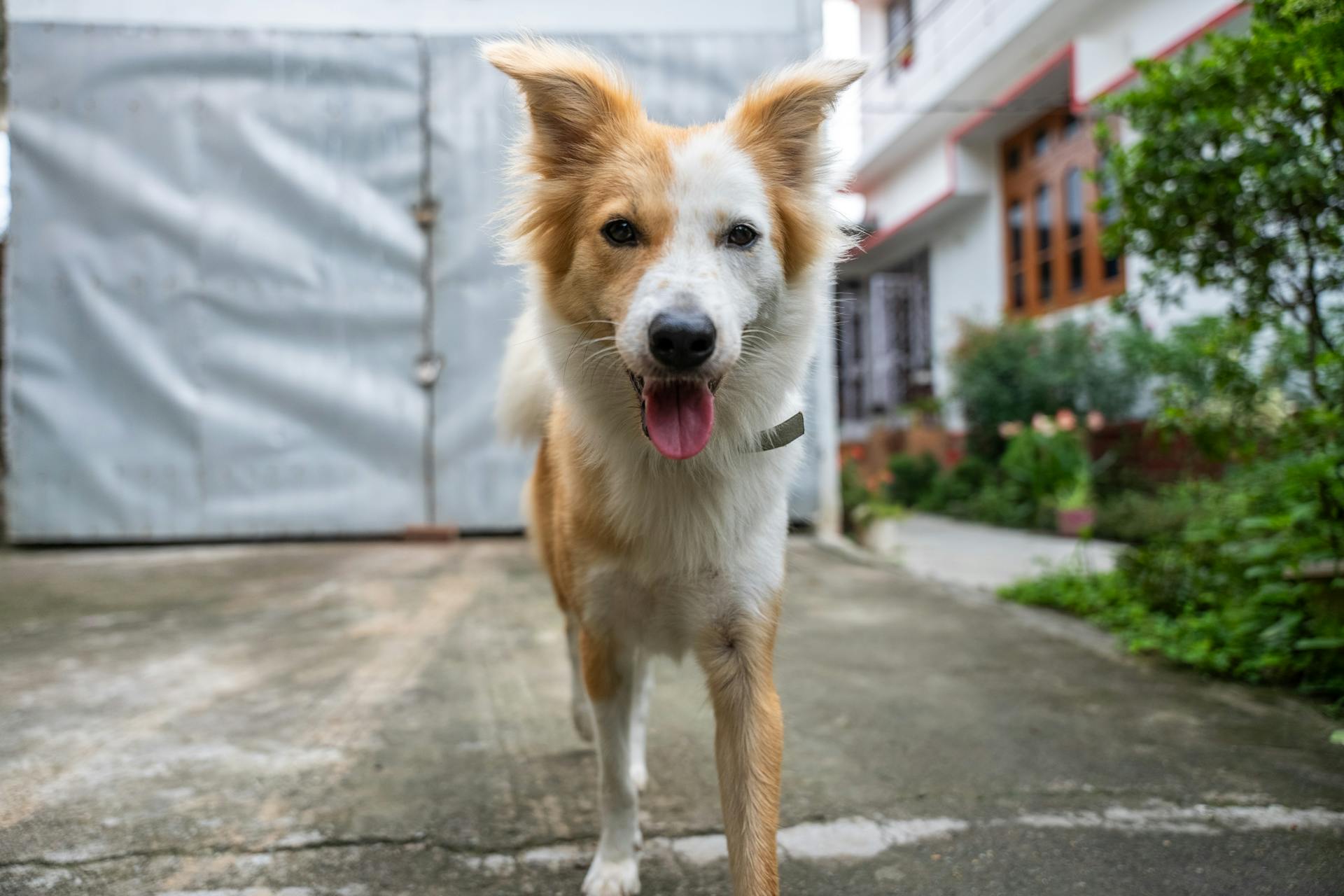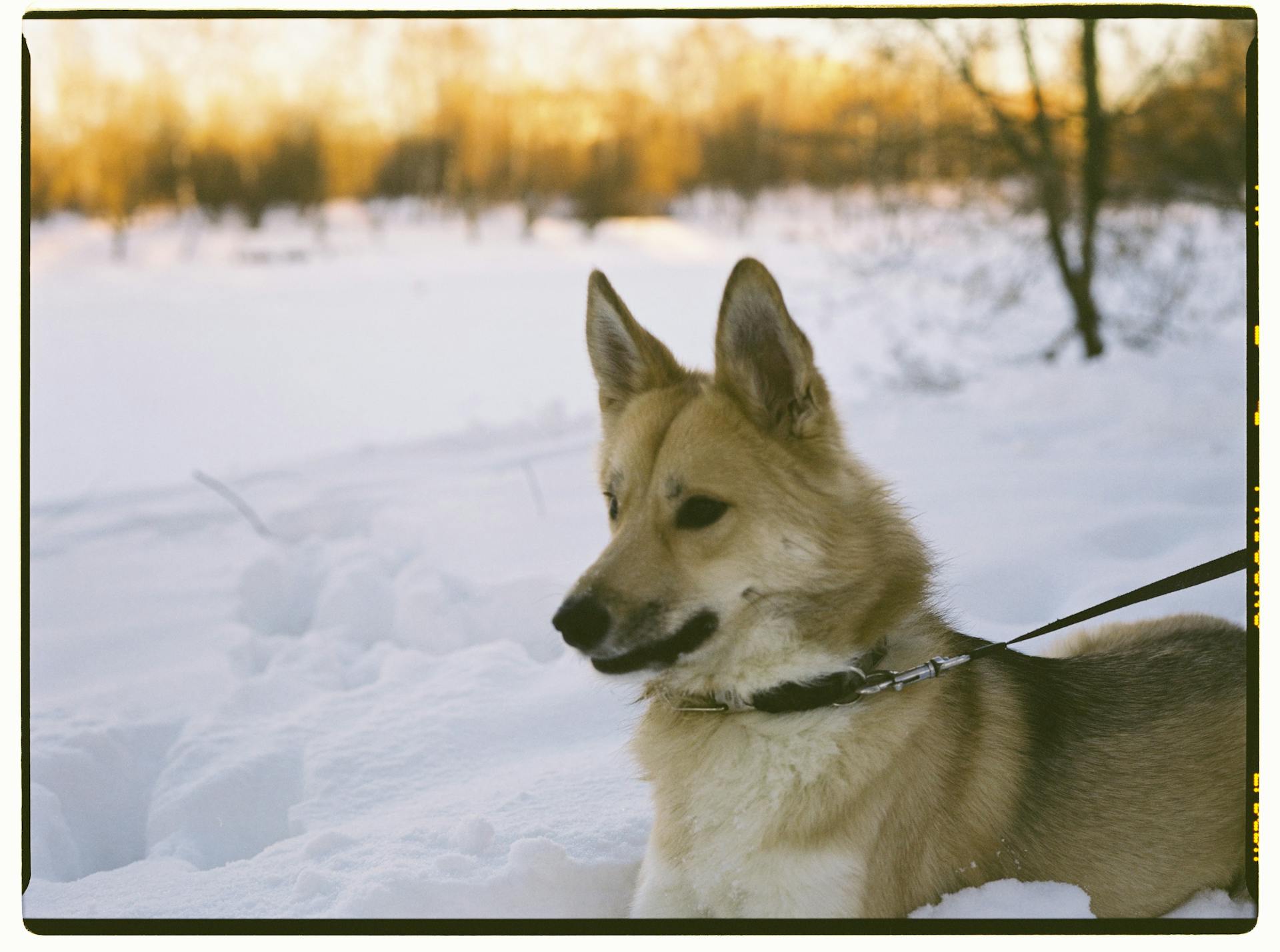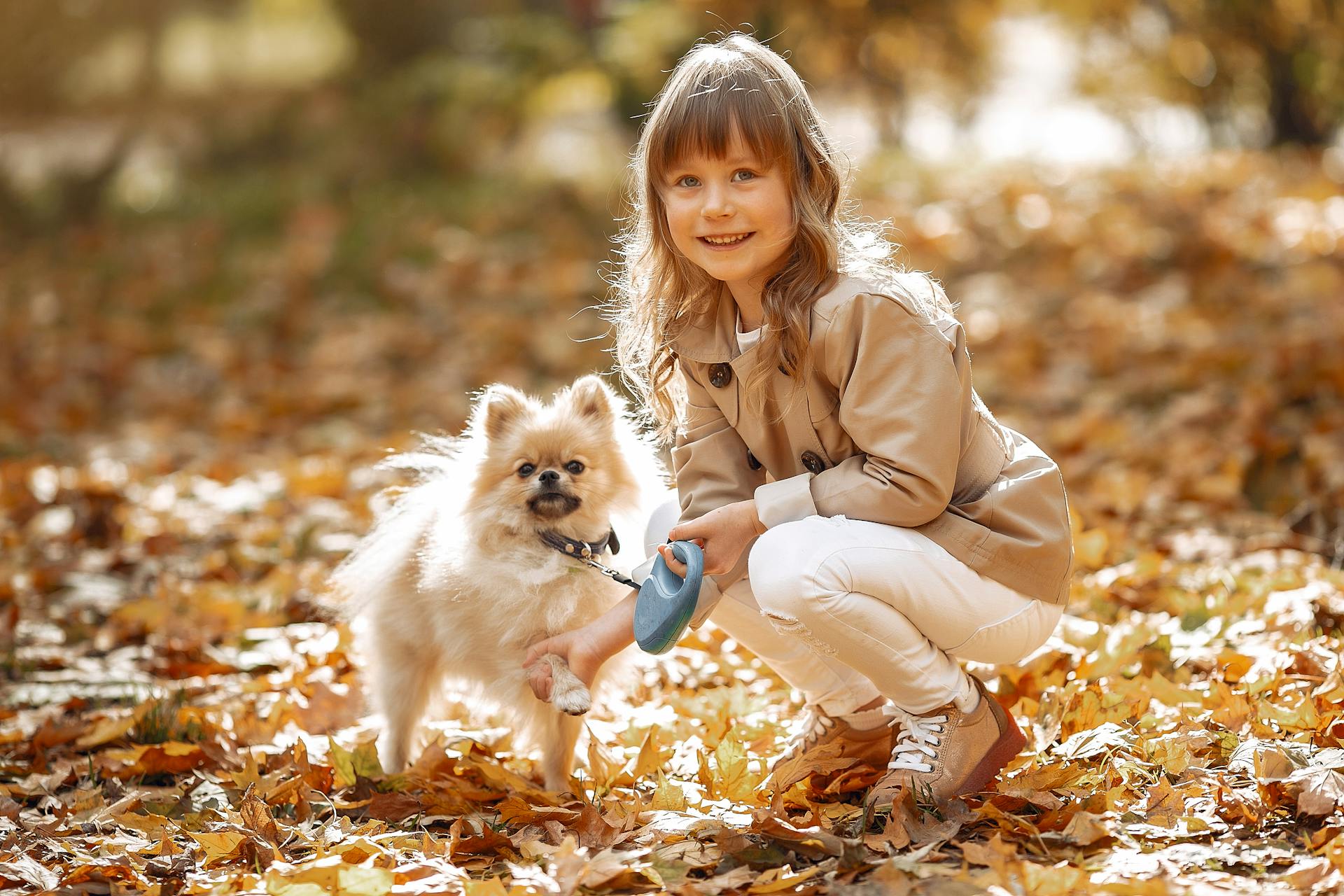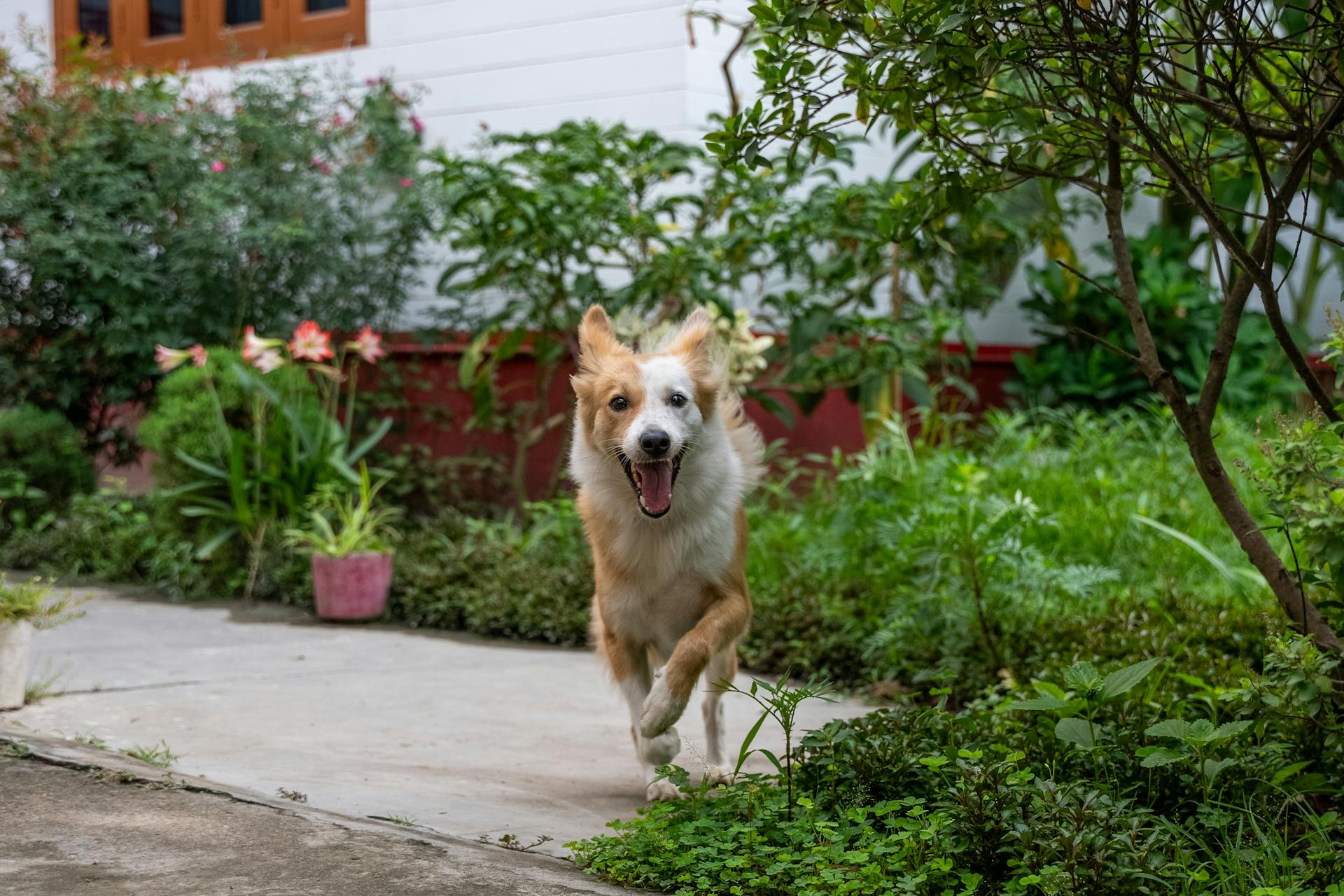
The Icelandic Sheepdog is an ancient breed that originated in Iceland over 1,000 years ago. They were bred to herd sheep and other livestock on the rugged Icelandic terrain.
This breed is known for its intelligence, energy, and strong herding instincts. They are highly trainable and thrive on mental and physical stimulation.
Icelandic Sheepdogs are medium-sized dogs with a sturdy build and a thick, double coat that sheds heavily. They require regular grooming to prevent matting and tangling.
With proper care and attention, Icelandic Sheepdogs can live up to 12-14 years.
Worth a look: Dogs Breeds That Start with B
Quick Facts
The Icelandic Sheepdog is a wonderful breed, and if you're considering bringing one home, here are some quick facts to get you started.
They originated in Iceland, brought by Viking settlers over a thousand years ago, and have been an essential part of Icelandic farm life ever since.
Icelandic Sheepdogs are small to medium-sized dogs, typically standing between 16 to 18 inches tall and weighing between 20 to 30 pounds.
Their lifespan is relatively long, ranging from 12 to 15 years, making them a long-term companion.
These dogs have a double coat that's perfect for the harsh Icelandic weather, with a medium-length outer coat and a soft, insulating undercoat.
Regular brushing is a must to prevent matting and keep their coat in good condition, especially during shedding seasons.
Icelandic Sheepdogs are known for their friendly and outgoing nature, making them great family companions and watchdogs.
Their herding instincts can make them watchful and protective, but they're also affectionate with their families and get along well with children and other pets.
They have a moderate level of energy and need regular exercise, such as daily walks and playtime, to stay mentally and physically stimulated.
These dogs are intelligent and eager to please, making them quick learners with positive reinforcement training methods.
Their grooming needs include regular ear cleaning to prevent infections and weekly brushing to keep shedding under control.
While they're generally hardy and healthy, Icelandic Sheepdogs can be prone to hip dysplasia and inherited eye conditions, so it's essential to work with a reputable breeder and keep up with regular check-ups.
Here's a quick summary of their key characteristics:
- Origin: Iceland
- Size: 16-18 inches tall, 20-30 pounds
- Lifespan: 12-15 years
- Coat: Double coat with medium-length outer coat and soft undercoat
- Temperament: Friendly, outgoing, watchful, and protective
- Exercise Needs: Moderate daily exercise
- Training: Positive reinforcement training methods
- Grooming: Regular ear cleaning and weekly brushing
- Health: Prone to hip dysplasia and inherited eye conditions
Breed Characteristics
Icelandic sheepdogs are highly intelligent and active dogs that thrive on mental and physical stimulation.
They are naturally herding dogs, bred to work with sheep and other livestock, and as such, they have a strong instinct to chase and herd.
Their high energy levels require regular exercise and mental stimulation to prevent boredom and destructive behavior.
Size
The Icelandic Sheepdog is a medium-sized dog, with males standing about 18 inches at the shoulder.
Females are slightly smaller, standing 16.5 inches tall.
Their weight is in proportion to their height, ranging from about 20 to 30 pounds.
You might like: Irish Wolfhound Standing
Appearance
The Icelandic Sheepdog's appearance is quite unique and endearing. Their double coat is a defining feature, with a longer outer coat and a dense undercoat.
Their coat can be a range of colors, including black, cream, fawn, gold, grey, red, sable, tan, or chocolate, always with white markings. This variety of colors is part of what makes the breed so visually appealing.
The Icelandic Sheepdog's face is perhaps their most distinctive feature, with dark brown almond-shaped eyes that give them a friendly and happy expression. Their perky ears add to their adorable appearance.
Their tail is bushy and often curves over their back, adding to their cute and endearing quality.
Similar Breeds
If you're unable to meet an Icelandic Sheepdog in person, but have access to similar breeds, it will give you a decent idea if this breed would be one you would like to live with.
One breed that's often compared to the Icelandic is the Norwegian Buhund. While they share similar characteristics, Buhunds have shorter coats and are more prey-driven on average.
Shetland Sheepdogs are also very similar to Icelandic Sheepdogs in terms of training and temperament. On average, icies are more social, while shelties tend to be more about their person/family.
Keeshonds are another breed that's similar to Icelandic Sheepdogs, with the main difference being color options and coat length.
Finnish Lapphunds are also similar, but they have more coat than the average icie and are slightly larger on average.
Here's a brief comparison of these breeds:
- Norwegian Buhunds: Shorter coats, more prey-driven
- Shetland Sheepdogs: Similar training and temperament, icies more social, shelties more family-oriented
- Keeshonds: Fluffier, one main color option
- Finnish Lapphunds: More coat, slightly larger, icies tend to be sharper and more driven
Training and Behavior
Icelandic sheepdog puppies are intelligent and quick learners, eager to please their owners. They thrive on positive training techniques and consistent reinforcement.
Early socialization is crucial for Icelandic sheepdogs, as they can be prone to separation anxiety if left home alone for long periods of time. This means introducing them to new people, places, and experiences from an early age.
Icelandic sheepdogs have a strong herding instinct, which can manifest as nipping at people's heels or trying to round up other pets. Providing them with outlets for this energy, such as walks and playtime, is essential for their well-being.
They are generally good with children, but supervision and proper socialization are still important to ensure positive interactions. Icelandic sheepdogs are naturally friendly and outgoing, making them excellent family dogs.
Consistent training methods and mental stimulation can help channel their intelligence and maintain their focus. They can be independent thinkers, so be prepared for the occasional display of stubbornness.
Icelandic sheepdogs are prone to vocalization, so it's essential to begin training them early and introduce "inside voice" commands. This can be a challenge, but with patience and persistence, you can help them develop good habits.
With proper training and socialization, Icelandic sheepdogs can make excellent hiking buddies, both on and off leash. They love water and swimming, making them a great choice for warmer hikes.
Consider reading: Why Do People like Chihuahuas
Health and Care
As an owner of an Icelandic Sheepdog, you'll want to be aware of the breed's potential health issues. Hip dysplasia is a common condition that can cause discomfort and mobility issues, so it's essential to work with a responsible breeder who conducts hip evaluations and uses screening programs to reduce the risk.
Regular veterinary check-ups are crucial to monitor your Icelandic Sheepdog's overall health and catch any potential issues early. This includes vaccinations, parasite prevention, and dental care. Don't forget to brush their coat regularly, especially during shedding seasons, to prevent matting and other health issues.
Icelandic Sheepdogs are intelligent and eager to please, making them generally responsive to training. Use positive reinforcement techniques like clicker training with treats or toy rewards to encourage good behavior and discourage unwanted behavior. With patience and consistency, you can shape your puppy's behavior and develop a strong bond with them.
If this caught your attention, see: Alaskan Malamute Behaviour
Health
Icelandic Sheepdogs are generally a healthy breed, but they can be prone to certain health conditions. Hip dysplasia is a common condition in many dog breeds, including the Icelandic Sheepdog, causing discomfort and mobility issues.

Regular veterinary check-ups are essential to detect and manage health issues early on. Responsible breeders will conduct hip evaluations and use screening programs to reduce the incidence of hip dysplasia in their breeding stock.
Patellar luxation is another condition that can affect Icelandic Sheepdogs, causing lameness and discomfort. Regular veterinary check-ups can help detect and manage this condition if present.
Progressive Retinal Atrophy (PRA) is a group of genetic eye disorders that can cause progressive vision loss and eventually lead to blindness. Responsible breeders will conduct eye examinations and use genetic testing to reduce the risk of PRA in their breeding programs.
Allergies can manifest as skin irritations, itching, and gastrointestinal issues in Icelandic Sheepdogs. Identifying and managing allergies may involve dietary changes, environmental modifications, and veterinary intervention.
Obesity is a common issue in many breeds, including Icelandic Sheepdogs, and can lead to various health issues. Maintaining a healthy weight is crucial to prevent strain on joints and reduce the risk of various health issues.
Regular veterinary check-ups, vaccinations, parasite prevention, and dental care are essential for maintaining the overall health of an Icelandic Sheepdog.
Take a look at this: Hip Dysplasia Bernese Mountain Dog
Care

Caring for your Icelandic Sheepdog requires regular grooming to prevent matting and keep their coat clean. Brush their coat at least once or twice a week, and more frequently during shedding seasons.
Their double coat sheds regularly, so be prepared for loose hair and tangles. Daily brushings during shedding season can help keep their fur under control.
Check their ears regularly for signs of infection and trim their nails as needed. Regular ear checks and nail trims can help prevent health issues.
Icelandic Sheepdogs are intelligent and love to please, making them responsive to positive reinforcement training methods. Clicker training with treats or toy rewards can be an effective way to train them.
They thrive on human companionship and attention, so spend quality time with your dog and provide them with affection. Icelandic Sheepdogs make great companions, but they require regular exercise and stimulation to prevent boredom and behavioral issues.

Take the time to ensure their ears are free of infection, nails are trimmed for comfort, and teeth are brushed often. A balanced diet that suits their age, activity level, and specific dietary needs is also essential for their overall health.
Regular veterinary check-ups can help monitor their overall health and address any health concerns that may arise. Follow the recommended vaccination schedule and administer preventive treatments for parasites like fleas, ticks, and heartworms.
History and Origin
The Icelandic Sheepdog has a rich history that spans over a thousand years, with its exact origins unclear but believed to have descended from dogs brought to Iceland by the Vikings during the 9th and 10th centuries.
These dogs were used for herding and protecting livestock, and over time, they adapted to the local conditions and developed into the breed we know today.
The breed's ability to work in challenging terrains and adverse weather conditions made it well-suited for the rugged Icelandic landscape.
The Icelandic Sheepdog played a vital role in Icelandic farming communities for centuries, herding sheep, guarding the flocks from predators, and assisting with other farm tasks.
However, by the mid-20th century, the breed was at the brink of extinction due to crossbreeding with other dog breeds and outbreaks of canine diseases.
Efforts to preserve and revive the Icelandic Sheepdog began in the 1950s, and through dedicated breeding programs, the breed's population slowly started to recover.
Today, the Icelandic Sheepdog is primarily kept as a companion dog and a working dog on farms, cherished for its friendly and sociable nature, as well as its ability to adapt to different environments and serve as a loyal family companion.
History
The Icelandic Sheepdog has a rich history dating back over a thousand years, with its origins tracing back to the 9th and 10th centuries when the Vikings brought their dogs to Iceland.
These Nordic spitz-type breeds helped the Vikings with herding and protecting their flocks, and over time adapted to the local conditions to become the Icelandic Sheepdog we know today.
You might enjoy: Straight Backed German Shepherds

The breed played a vital role in Icelandic farming communities for centuries, herding sheep, guarding flocks from predators, and assisting with farm tasks.
Their ability to work in challenging terrains and adverse weather conditions made them well-suited for the rugged Icelandic landscape.
In the 19th and early 20th centuries, the Icelandic Sheepdog population declined due to crossbreeding with other breeds and canine diseases.
By the mid-20th century, the breed was at the brink of extinction, but dedicated breed enthusiasts worked to revive and preserve the breed.
Their efforts led to the breed's recognition by the Icelandic Kennel Club in 1969, and today the Icelandic Sheepdog is cherished for its friendly and sociable nature.
The breed's history helps explain their instincts and behaviors, such as alerting their owners to anything different in their environment.
To understand and work with these instincts, it's essential to provide the breed with a big world to explore and learn from, rather than keeping them confined to a small space.
This approach helps them understand what's normal and what's not, making them more aware of their surroundings and less likely to bark excessively.
Icelandic
Icelandic is a North Germanic language, closely related to Old Norse. It's the official language of Iceland and has its own unique grammar and vocabulary.
The Icelandic language has retained many of its ancient features, making it a fascinating subject for linguists. It's the closest living language to Old Norse, which was spoken by the Vikings.
Icelandic has a relatively simple grammar system, with only two grammatical cases. It also has a unique alphabet, using letters like þ and ð.
The language has a rich literary tradition, with the medieval Icelandic Sagas being some of the most famous works of medieval literature. These stories were written in the 12th to 14th centuries and are still studied and admired today.
Icelandic is also an official language of the European Union, recognized by the EU's Charter on Regional or Minority Languages. This recognition provides a level of protection and support for the language.
The Icelandic language has a strong presence in Icelandic culture, with many festivals and events celebrating its use and preservation.
Living with an Icelandic Sheepdog
Living with an Icelandic Sheepdog can be a wonderful experience, but it's essential to understand their needs and quirks. They thrive in active homes that include them in all activities.
Icelandic Sheepdogs have moderate to high energy, so they need regular exercise to be happy members of the family. This can be achieved through activities like hiking, daily walks, running, or training classes.
They can live in apartments if well-exercised and trained, but may be a problem for neighbors due to their tendency to bark loudly. It's crucial to begin training early and focus on introducing "inside voice" commands.
Icelandic Sheepdogs typically do well living alongside other dogs, especially if raised with feline siblings. However, it's essential to introduce them properly and supervise interactions with children.
What's It Like to Live with an Icelandic Sheepdog?
Living with an Icelandic Sheepdog can be a wonderful experience, but it's essential to consider their needs and characteristics. They can thrive in apartments if well-exercised and trained.
Their barking can be a challenge, especially if you live in a residential area. Icelandic sheepdogs have the bark of a larger dog, and some may express themselves loudly.
Proper training and early socialization are crucial to address this issue. Introducing "inside voice" commands can help, but it may be tricky to reinforce over time.
Icelandic sheepdogs generally get along well with other dogs and can make great playmates for children. However, it's essential to supervise interactions and teach kids how to properly interact with dogs.
If you have a cat, introducing them properly is key to a harmonious household. They may try to herd the cat due to their herding instincts, but with careful introduction, they can live well together.
A fresh viewpoint: How Long Do Border Collies Live
Information and Pictures
Living with an Icelandic Sheepdog requires a good understanding of their unique characteristics. They are a medium-sized breed with a muscular build and a thick double coat that sheds heavily.
Their thick coat needs regular grooming to prevent matting and tangling. Brushing their coat daily can help reduce shedding and prevent hairballs.
Icelandic Sheepdogs are highly intelligent and trainable, but they can be stubborn at times. Consistent training and positive reinforcement are key to developing good behavior.
They are a relatively healthy breed with an average lifespan of 12-15 years. Regular veterinary check-ups and preventative care can help prevent health issues.
Their high energy level requires regular exercise to keep them happy and healthy. Daily walks and playtime are essential to meet their physical and mental needs.
Their strong herding instinct can make them prone to chasing small animals, so supervision is necessary when interacting with pets.
Frequently Asked Questions
How much is an Icelandic Sheepdog?
The cost of an Icelandic Sheepdog can range from $1000 to $2000, influenced by factors like breeder reputation, location, and intended use. If you're interested in bringing an Icelandic Sheepdog into your family, we'd be happy to provide more information on what to expect.
Are Icelandic Sheepdogs rare?
Yes, Icelandic Sheepdogs are a rare breed, with only around 100 puppies born annually in Iceland. Their rarity can make them harder to find, but it's worth the search for those interested in this unique breed.
Are Icelandic Sheepdogs good pets?
Icelandic Sheepdogs make great family pets due to their loving and loyal nature. They thrive on attention and affection, making them ideal companions for active families.
How many Icelandic Sheepdogs are there in the USA?
There are over 800 Icelandic Sheepdogs in the United States. The American Kennel Club recognized the breed in June 2010, marking a significant milestone in its growing popularity.
Featured Images: pexels.com


